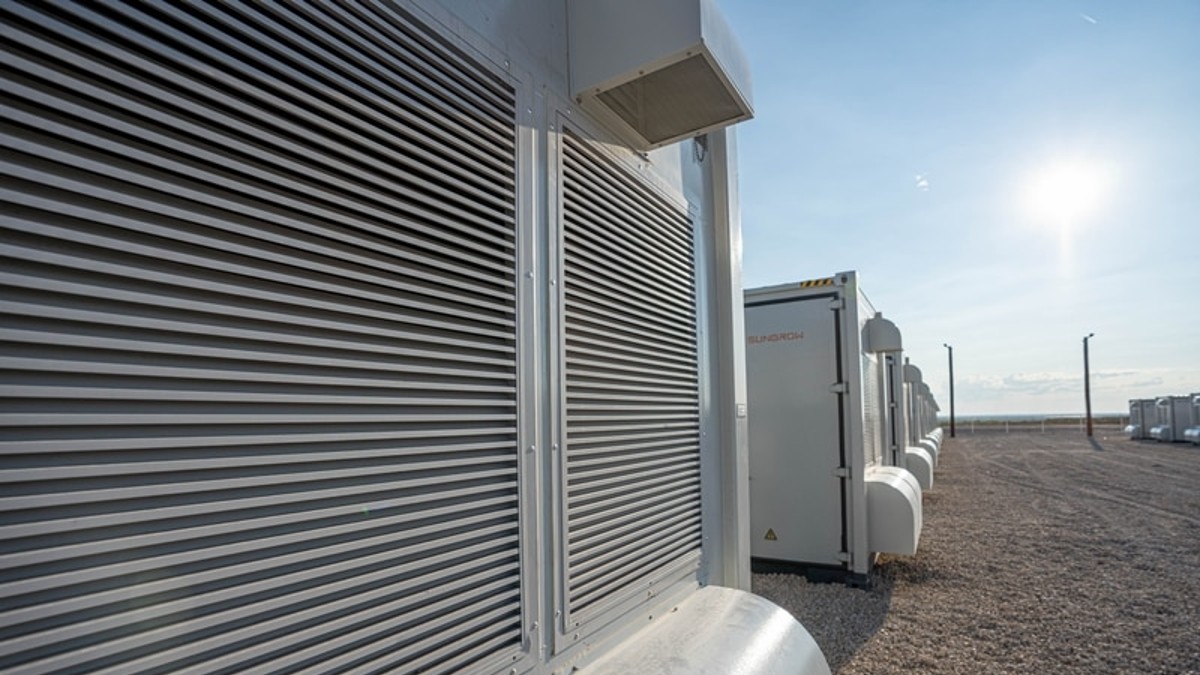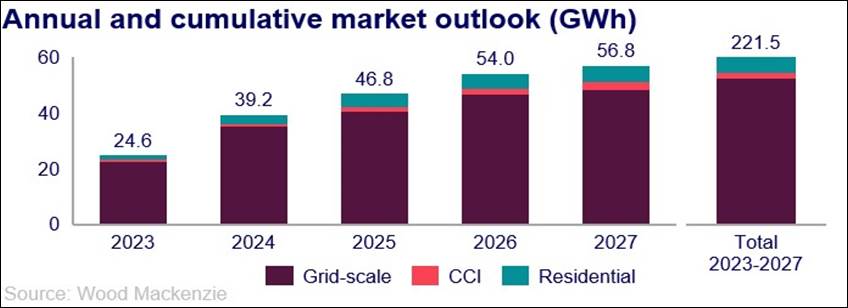
The US battery energy storage market added 5,597 megawatt hours (MWh) in the second quarter of 2023, a new quarterly record.
The grid-scale segment of the industry drove the market with a record-breaking 5,109 MWh in Q2, beating the previous record in Q4 2021 by 5%, according to Wood Mackenzie and the American Clean Power Association’s (ACP) latest US Energy Storage Monitor report.

The grid-scale segment achieved 172% growth quarter-over-quarter. California was No. 1 among states with the most grid-scale energy storage installations, with 738 MW and a 49% share of installed capacity.
Wood Mackenzie projects the grid-scale segment to be the main driver of the market in its five-year forecast from 2023-27, accounting for 83% of total installations, or 55 gigawatts (GW).
ACP’s VP of research and analytics, John Hensley, said:
The energy storage market is on pace for a record year, as utilities and larger power users increasingly turn to storage to enhance the grid and improve reliability.
The market is on pace to nearly double annual installations despite supply chain challenges and interconnection delays, and will continue to grow quickly in coming years.
Community, commercial, and industrial (CCI) installations, at 107 MWh, were higher than any quarter in 2022 but couldn’t keep pace with the huge spike in Q1 installations, resulting in a 53% quarterly decline. However, the segment is still up 25% year-over-year.
Residential storage saw its second-straight quarter of decline at 381.2 MWh, behind Q1’s 388.2 MWh. California saw the biggest decline, decreasing 17% quarter-over-quarter and 37% year-over-year.

Vanessa Witte, senior analyst with Wood Mackenzie’s energy storage team, said, “We still project strong growth for the residential segment in our five-year outlook, reaching a total of 8 GW in 2027. However, the CCI segment continues to fail to meet growth projections and we have downgraded its five-year growth forecast by 28% to 3 GW.”
On Friday, the US Department of Energy (DOE) announced up to $325 million for 15 projects across 17 states and one tribal nation to accelerate the development of long-duration energy storage (LDES) technologies. The DOE has set a goal to reduce the cost of LDES by 90% by 2030.
Read more: Volvo is going to turn used EV batteries into new battery storage
Photo: Jupiter Power; Graphs: US Energy Storage Monitor Q3 2023 | American Clean Power Association, Wood Mackenzie
If you’re considering going solar, it’s always a good idea to get quotes from a few installers. To make sure you find a trusted, reliable solar installer near you that offers competitive pricing, check out EnergySage, a free service that makes it easy for you to go solar. It has hundreds of pre-vetted solar installers competing for your business, ensuring you get high-quality solutions and save 20-30% compared to going it alone. Plus, it’s free to use, and you won’t get sales calls until you select an installer and share your phone number with them.
Your personalized solar quotes are easy to compare online, and you’ll get access to unbiased Energy Advisors to help you every step of the way. Get started here. –ad*

The RDL is known for its deeper stretch within the hamstrings
and glutes, making it an excellent choice for specifically concentrating on these muscle
tissue. The stiff leg and standard Romanian deadlift differ when it comes to muscle
activation. The stiff leg deadlift emphasizes the hamstrings whereas the standard Romanian deadlift
targets both the hamstrings and glutes. Each workouts contain hip hinging
and could be included into a well-rounded coaching program.
Muscle mass and strength constructing are important issues in any strength
training program, and the deadlift and Romanian deadlift are each effective workouts for achieving these goals.
Both exercises involve a quantity of muscle groups and can be utilized to build endurance and
improve general fitness. The traditional deadlift, also known as the conventional deadlift, is the king of all weight lifting workout routines.
Common deadlifts are generally thought-about tougher due to the heavier weight and full-body involvement.
There are completely different recommendations on the units and weights really helpful for the 2, but I personally come from
an athletics background. In that regard, I advocate the usual
deadlift as a low-rep, excessive weight,
explosive exercise. In The Meantime, I all the time used the RDL as a lower weight, larger rep exercise meant to work along side, say, squats as a super-set
or antagonizing set. The major muscle tissue used within the
Romanian Deadlift, or RDL, are the hamstrings, the rhomboid muscle group, the glutes, and the erector spinae.
Whether you carry out the motion with dumbbells, a kettlebell
or a barbell, all of them deserve a spot in your exercise routine.
RDLs develop the energy of the posterior chain muscle tissue,
together with the erector spinae, glutes, hamstrings and adductors.
The RDL is an excellent accent motion used to strengthen a lifter’s traditional deadlift.
The Romanian deadlift was named after the Romanian weightlifter Nicu Vlad, an Olympic medalist.
After coaching his clean and jerk, Vlad had been noticed performing these flat-backed deadlift-like
workouts. Particularly, we will be diving deep into the principle variations between these two exercises, corresponding to which is best for strength training, hamstring development,
and aesthetic goals. Whether Or Not you’re seeking to pack on muscle mass or build energy, the deadlift is
a great train to add to your routine. Start gentle and hold the weights near your body as you lower them down your shins.
The first thing to debate are the primary differences between Romanian deadlifts and traditional deadlifts.
The Romanian deadlift (RDL) and the single-leg deadlift (SLDL) are two well-liked workout routines that concentrate on the
hamstrings, glutes, and decrease again. Both are effective at
building energy and improving athletic efficiency, but they have some key differences.
Understanding these differences may help you determine which train is right for you.
The quest for a sculpted and highly effective lower physique
is a typical goal for many fitness fanatics.
Two workouts that persistently make their method into exercise routines are the Romanian deadlift (RDL) and lunges.
Each movements effectively target the hamstrings, glutes, and quads, however they differ in their mechanics and general advantages.
By understanding their variations and advantages, you also can make
knowledgeable decisions to achieve your required results.
Keep In Mind to prioritize proper type, hearken to your physique, and enjoy the
strategy of building a stronger and more healthy you.
The Romanian Deadlift primarily targets the hamstrings, glutes, and
decrease back, with secondary activation within the quadriceps and calves.
By focusing on the posterior chain, the RDL is a fantastic train for developing strength and stability at the back of the legs.
A three-dimensional evaluation printed within the
journal of Medical Science and Sports Exercise at Duke College compared
the biomechanics of the standard deadlift vs sumo deadlift.
With the standard deadlift, we deliver our hips near the bar,
enhancing our leverage, and we bend our knees on the
bottom, permitting our quads to help push the burden up.
That means more weight in our hands, more weight
supported by our spinal erectors and traps, and more weight to tug with
our lats and rear delts. Because of the variations between the standard
deadlift and the Romanian deadlift, it’s not a nasty concept to
include both methods in your exercises. Other widespread
leg workout routines, like squats and lunges,
may additionally be added to your leg training routine.
But more individuals debate which deadlift should be your first selection for health.
This train is a strong exercise that works muscles
that traditional deadlifts cannot.Which train you decide to make
use of deserves your attention? Fortunately, we now have professional fitness trainers right here to research both workouts and give you an concept of which one is healthier for you and your coaching targets.
Executing correct method is essential for maximizing the advantages of these two variations of
the exercise. In deadlift, the lifter begins with a
concentric vary of movement, pushing off the floor with
their knees. The shoulders are slightly in entrance of the barbell,
and the lifter engages their quads and mid-back. On the other hand, Romanian deadlift begins
with an eccentric range of motion, pulling from the hips, with the shoulders much additional in front of the barbell.
And with a bar shaft that’s balanced, ground, polished,
and tested, you’ll all the time have the proper amount
of fluid, flexing movement by way of your lift. Plus, a shiny zinc coating protects against scratches and corrosion,
whereas bronze bushings between the shaft and sleeve provide a easy and consistent roll.
Let’s break down the variations between these two essential lifts—and how to choose
between them for your coaching. You will be in a position to raise more weight with the deadlift vs Romanian deadlift.
The Romanian deadlift was rated as certainly one of my prime deadlift progressions
to take your raise from a newbie to advanced stage.
References:
National Geographic Science Of Steroids (Git.Ascarion.Org)
70918248
References:
ulisses jr Steroids (jobs.kwintech.co.ke)